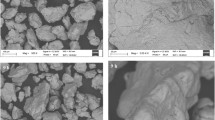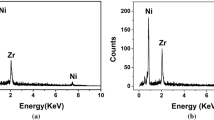Abstract
The paper reports on a nanoindentation study of the hardness H and Young’s modulus E in the B2 phase of quasi-binary TiNi-TiFe single crystals and Ti49Ni51 single and polycrystals with and with no thermoelastic martensite transformations. The study shows that the elastic properties of the alloy single crystals depend on the concentration of Fe atoms and decrease gradually with a decrease in the Fe content and with a gradual decrease in the B2-phase stability to martensite transformations. In Ti50Ni50–xFex, the dependence of the hardness H on the Fe content reveals a peak at equal Fe and Ni concentrations (25.0 at %), which is likely because the alloy at this Fe/Ni ratio is involved in its maximum solid solution hardening. The experimental results are compared with numerical data obtained by the Voigt averaging of elastic constants, showing a mean deviation of 11.55% between them. An analysis of the H and E correlation and the H/E ratio in the alloys as they lose the B2-phase stability to martensite transformations suggests that the correlation coefficient of E and H in TiNiFe measures 0.42, which corresponds to the range of moderate statistical values. In TiNi-TiFe with martensite transformation, the ratio H/E is higher than 0.035, and hence, higher than the values typical of metals and alloys. In our opinion, this is because the elastic moduli of the alloys are “softened” as they get close in concentration to the points of B2 → R → B19′ transitions. The H/E ratio in the alloys can be considered as a criterion of B2-phase stability loss with respect to martensite transformations.






Similar content being viewed by others
REFERENCES
Qian, L. and Xiao, X., Anomalous Relationship between Hardness and Wear Properties of a Superelastic Nickel-Titanium Alloy, Appl. Phys. Lett., 2004, vol. 84, no. 7, pp. 1076–1078.
Musil, J., Kunc, F., Zeman, H., and Poláková, H., Relationships between Hardness, Young’s modulus and Elastic Recovery in Hard Nanocomposite Coatings, Surf. Coat. Technol., 2002, vol. 154, no. 2–3, pp. 304–313.
Cheng, Y.T. and Cheng, C.M., Scaling, Dimensional Analysis, and Indentation Measurements, Mater. Sci. Eng. R. Rep., 2004, vol. 44, pp. 91–149.
Cheng, Y.-T. and Grummon, D.S., Indentation in Shape Memory Alloys, in Micro and Nano Mechanical Testing of Materials and Devices, New York: Springer, 2008, pp. 71–86. https://doi.org/10.1007/978-0-387-78701-5
Firstov, S.A. and Rogul, T.G., Theoretical (Ultimate) Hardness, Rep. Nat. Acad. Sci. Ukraine, 2007, no. 4, pp. 110–114.
Muslov, S.A., Shelyakov, A.V., and Andreev, V.A., Shape Memory Alloys: Properties, Production, and Application in Engineering and Medicine, Moscow: Mozartika, 2018.
Sellitto, A and Riccio, A., Overview and Future Advanced Engineering Applications for Morphing Surfaces by Shape Memory Alloy Materials, Materials, 2019, vol. 12(5), p. 708. https://doi.org/10.3390/ma12050708
Valiev, R.Z., Prokofiev, E.A., Kazarinov, N.A., Raab, G.I., Minasov, T.B., and Strásky, J., Developing Nanostructured Ti Alloys for Innovative Implantable Medical Devices, Materials, 2020, vol. 13(4), p. 967. https://doi.org/10.3390/ma13040967
Lotkov, A.I., The Physical Nature of TiNi Based Alloys B2 Phase Instability: Achievements and Perspectives, in Shape Memory Materials’94: Proc. Int. Symp., Sept. 25–28, 1994, Beijing, China, Beijing, 1994, pp. 24–30.
Titanium Nickelide Shape Memory Alloys. Part. 1. Structure, Phase Transformations, and Properties, Pushin, V.G., Ed., Yekaterinburg: UrB RAS, 2006.
Fedotkin, A.P., Laktionov, I.V., Kravchuk, K.S., Maslenikov, I.I., and Useinov, A.S., Automatic Processing of Microhardness Images Using Computer Vision Methods, Instrum. Exp. Tech., 2021, vol. 64(3), pp. 357–362.
Muslov, S.A., Khachin, V.N., Pushin, V.G., and Chumlyakov, Yu.I., Elastic Properties and Structure of Alloys TiNi-TiFe before Martensitic Transformations, Lett. Mater., 2015, vol. 5, no. 4, pp. 420–423.
Oliver, W.C. and Pharr, G.M., An Improved Technique for Determining Hardness and Elastic Modulus Using Load and Displacement Sensing Indentation Experiments, J. Mater. Res., 1992, vol. 6, no. 7, pp. 1564–1583.
Nakanishi, N., Elastic Constants as They Relate to Lattice Properties and Martensite Formation, Progr. Mater. Sci., 1979, vol. 24, nos. 3–4, pp. 143–265.
Mercier, O., Melton, K.N., Gremaud, G., and Hagi, J., Single-Crystal Elastic Constants of the Equiatomic NiTi Alloy near the Martensitic Transformation, J. Appl. Phys., 1980, vol. 51, no. 3, pp. 1833–1834.
Kornilov, I.I., Belousov, O.K., and Kachur, E.V., Titanium Nickelide and Other Alloys with Memory Effect, Moscow: Nauka, 1977.
Li, P., Karaca, H.E., and Cheng, Y.-T., Spherical Indentation of NiTi-Based Shape Memory Alloys, J. Alloys Compnd., 2015, vol. 651, pp. 724–730.
Kuznetsov, A.V., Muslov, S.A., Lotkov, A.I., Khachin, V.N., Grishkov, V.N., and Pushin, V.G., Elastic Constants of TiNi near Martensitic Transformations, Izv. Vyssh. Uchebn. Zaved. Fiz., 1987, no. 7, pp. 98–99.
Muslov, S.A., Kuznetsov, A.V., Khachin, V.N., Lotkov, A.I., Pushin, V.G., and Grishkov, V.N., Anomalies of the Elastic Constant of Single Crystals Ti50Ni48Fe2 near Martensitic Transformations, Izv. Vyssh. Uchebn. Zaved. Fiz., 1987, no. 8, pp. 104–105.
Shermergor, T.D., Elasticity Theory of Microinhomogeneous Materials, Moscow: Nauka, 1977.
Funding
The work was performed under State Assignment for ISPMS SB RAS (project No. FWRW-2021-0004).
Author information
Authors and Affiliations
Corresponding author
Additional information
Translated from Fizicheskaya Mezomekhanika, 2022, Vol. 25, No. 6, pp. 57–62.
Rights and permissions
About this article
Cite this article
Muslov, S.A., Lotkov, A.I. Nanohardness and Elastic Modulus of TiNi-TiFe Single and Polycrystals. Phys Mesomech 26, 152–156 (2023). https://doi.org/10.1134/S1029959923020042
Received:
Revised:
Accepted:
Published:
Issue Date:
DOI: https://doi.org/10.1134/S1029959923020042




